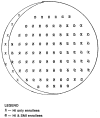Medicare's common denominator: the covered population
- PMID: 10309331
- PMCID: PMC4191140
Medicare's common denominator: the covered population
Abstract
This report describes Medicare eligibility requirements: the processes to establish Medicare entitlement; types of coverage; the composition of the enrolled population; and outlines some differences in measurement techniques used in a decennial census in contrast to Medicaid enrollment. Current Medicare enrollment figures do not represent a complete count of any segment of the total United States population. Some persons age 65 and over are not eligible for Medicare; others are eligible but not entitled. However, the Medicare enrollment figures are frequently used as surrogate counts of the aged population because they provide excellent sources of detailed demographic and geographic information for a large proportion of those age 65 and over. The data are produced semi-annually, based on daily updates.
Figures
References
-
- Health Care Financing Administration Office of Policy, Planning and Research. Medicare: Health Insurance for the Aged and Disabled, 1975, Enrollment. Washington, D.C.: 1978. pp. 2–3. Table 2.1.
-
- Social Security Administration, Division of Claims Policy Report on Proof of Age Validation Study—Domestic Born Adults. 1965 Apr;
-
- Social Security Administration Office of Program Policy and Planning. Report on Policies and Procedures for Establishing Initial Entitlement to RSDI Benefits. 1978 Dec;
-
-
The 1980 Annual Report of the Board of Trustees of the Federal Hospital Insurance Trust Fund, p. 4.
-
-
- U.S. Bureau of Census Census of Population Housing. Estimates of Coverage of Population by Sex, Race, and Age: Demographic Analysis. Evaluation and Research Program, PHC (E)-4. 1970. p. 17.
MeSH terms
LinkOut - more resources
Full Text Sources
Medical


